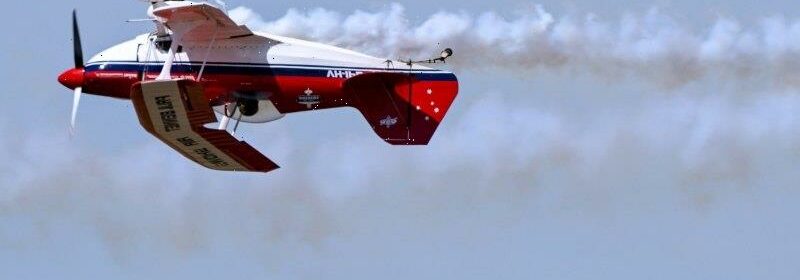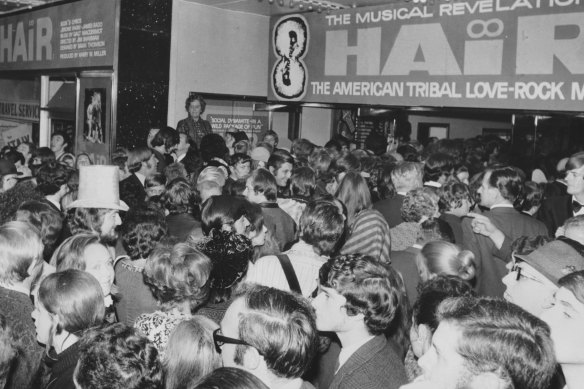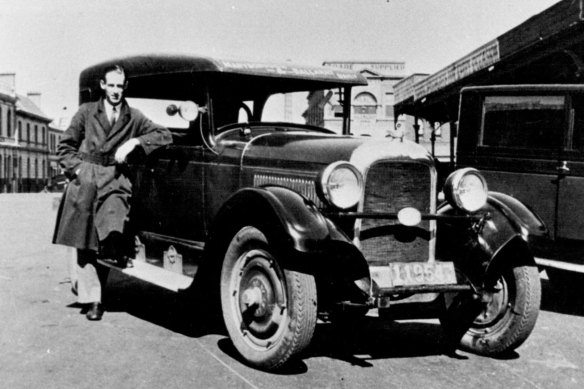The Age of Aquarius, when country folk could still fly

The plane roared out of the predawn sky and taxied to the shed that served as our airport terminal. Blue lights lined the runway, lending the dark a brilliance I would never forget.
It was to be my first junket as a cadet journalist: a flight from our coastal town to Melbourne, a night in a big-city hotel and – Great Hare Krishnas! – a front-row seat to the hottest musical in the world, Hair.
May 21, 1971: The opening night crowd outside the Metro Theatre in Bourke Street for Hair.Credit:Age photographer
It was 1971: the dawning of the Age of Aquarius.
Premier Henry Bolte’s vice squad was said to be ready to pounce if the cast used four-letter words or took off their clothes.
The cast did both, but the vice police stayed home, possibly embarrassed because the hippy musical had already played for two years, unmolested, in Sydney.
Melbourne’s social set, keen to prove their town was as sophisticated as the sin city of the north, all but broke down the doors of the Metro Theatre in Bourke Street to get a seat.
Someone in a publicity department figured it would be a fine idea to generate extra excitement among prospective theatregoers from country areas.
And so I, a cadet at The Portland Observer in south-west Victoria, was knocked sideways with excitement to receive a plane ticket from Ansett Airlines, a room at the Hotel Australia in Collins Street and a choice seat to Hair. All I had to do was write a story about the escapade.
If this, I figured, was what journalism was about, I wasn’t quitting. Ever.
All these years later, my principal astonishment concerning the old jaunt to Hair is that I was able to fly to and from Melbourne. It’s been years now since anyone could catch a regular passenger plane anywhere in south-west Victoria.
Portland has a fine airport (built to replace the old one in 1982), but there’s been no passenger service since 2019. Same for Warrnambool, a booming regional city of 35,000 people.
Sharp Airlines, the last of a series of companies to fly the route since Ansett collapsed in 2001, announced on a black day in May 2019 that it was ending its passenger service between Melbourne and both Portland and Warrnambool.
A bit up the road, the city of Hamilton – where Ansett and Sharp were both founded and whose airport boasts the Sir R.M. Ansett terminal – hasn’t seen a regular airline passenger since 2014.
Governments willing to pay billions of dollars in the cause of getting people around our state’s capital, Melbourne, on trains and trams and along freeways and through tunnels, appear to have lost the wit or the will to find ways of also helping support convenient means of swift transport for country residents.
It’s the road or nothing, mostly, these days.
Driving four hours from the south-west to Melbourne the other day, I passed Avalon Airport outside Geelong, where the nation’s largest air show was about to blast off, planes of all descriptions gathering from around the world.
A display during Avalon Airshow’s media preview at the Avalon Airport in February.Credit:Eddie Jim
The more things hurtle into the future, I mused, the more things can go backward, especially in country districts.
When I caught that Ansett Fokker Friendship in 1971, I could have travelled instead to Melbourne by train, should I have chosen. Passenger trains from Portland haven’t run since the early 1980s. Hamilton has had no passenger rail service since then, either.
It’s a similar story right across the farther-flung areas of Victoria.
If you haven’t got a car, the best you can hope for in many areas is to catch a bus.
In my own home territory, there remains a train, mercifully, between Melbourne and Warrnambool. But if you want to travel further west than Warrnambool? Take the bus.
There are many compensations for living beyond the big city, of course. You’re unlikely to spend much of your life stuck in a traffic jam, abundant open countryside is everywhere, there are dreaming mountains, and down south, seascapes set the heart soaring.
But distance has always been a challenge, and governments aren’t always there to help.
In the 1930s, a bloke named Reg Ansett bought an old Studebaker car and began carrying passengers around western Victoria.
When the service proved popular and Ansett expanded his operation with several more cars, a politician by the name of Robert Menzies decided he’d seen enough.
Reg Ansett in 1931 with his first road service Studebaker, running daily from Maryborough to Ballarat. Moving to Hamilton proved a moneymaker.Credit:Age archives
Menzies, who would go on to become Australia’s longest-serving prime minister, was Victoria’s State Minister for Railways in the mid-1930s.
He saw Ansett’s road service as a threat to the railways. Putting aside his commitment to free enterprise, Menzies sponsored legislation that denied Ansett the right to carry fee-paying passengers.
Ansett cannily retaliated by taking out a fruit vendor’s licence.
Anyone willing to pay £2 and 10 shillings for an orange would get a “free” ride in one of his cars from Hamilton to Melbourne or return.
Ansett became so successful that within a year he established Ansett Airways. In 1936 the airline began flying passengers between Hamilton and Melbourne.
Ansett became so ascendant its Fokker Friendships flew just about everywhere, including Portland.
Which is how, as a cub reporter in 1971, I was able to hurtle to Melbourne in less than an hour to attend the world’s hottest musical.
Fifty-two years later, it’s a trip of four hours, minimum.
The Age of Aquarius, as it happens, proved to be a false dawn too.
Most Viewed in Politics
From our partners
Source: Read Full Article


